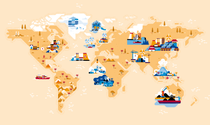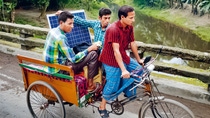Magazine
The world as an energy producer
How nature supplies us with more and more electricity.
Our infographic takes a look around the globe and offers some surprising facts about electricity and energy.
Click the plus signs to learn more.

Arctic Circle
Server farms are found more and more frequently in places such as Iceland, Norway or Alaska, where the cold conditions mean less electricity is used to cool the units. Nevertheless, digitalization requires a lot of energy. If the internet were a nation, it would have been the sixth-largest electricity consumer in the world as early as 2017.
Iceland
The island nation has by far the highest per capita electricity consumption level in the world, mainly due to the aluminum industry. However, Iceland’s electricity is completely climate-friendly, generated solely from hydroelectric and geothermal energy. Geothermal heat also enables bananas to grow despite icy temperatures – in greenhouses heated by hot water from underground.
–
Renewables as a proportion of electricity generated (2018): 100%
Electricity consumption per capita (2018): 54.6 MWh
USA
In many countries, industry uses more electricity than private households. But that is not the case in the USA, where the proportion used in private homes is almost twice as high. The most recent figure for total power consumption in the USA was 4,289 terawatt-hours.
–
Renewables as a proportion of electricity generated (2018): 17 %
Electricity consumption per capita (2018): 13.1 MWh
United Kingdom
Dogger Bank is due to become the world’s largest wind power project, with what will also be the world’s tallest wind turbine, at 260 meters, due to be in operation from 2023. According to the IEA, sea-based wind power is becoming increasingly competitive. Global capacity could triple to 65 gigawatts by 2024 and then account for almost 10 percent of the world’s wind power production.
–
Renewables as a proportion of electricity generated (2018): 33 %
Electricity consumption per capita (2018): 4.9 MWh
Germany
Globally, hydroelectric power is the dominant source of renewable energy production. In Germany, however, more than half comes from wind power. Regarding global wind power capacity, Germany ranks third – after China and the USA – in terms of megawatt-hours produced.
–
Renewables as a proportion of electricity generated (2018): 35 %
Electricity consumption per capita (2018): 6.9 MWh
France
The French obtain about three-quarters of their electricity from nuclear power stations – more than any other country in the world. That proportion is due to fall to 50 percent by 2035, with wind and solar power being significantly expanded.
–
Renewables as a proportion of electricity generated (2018): 20 %
Electricity consumption per capita (2018): 7.1 MWh
Poland
Warsaw has so far rejected the European Union’s goal of becoming climate-neutral by 2050. About 70 percent of its electricity comes from coal, which is used mainly by private households. That proportion is due to fall to 50 percent by 2050.
–
Renewables as a proportion of electricity generated (2018): 13 %
Electricity consumption per capita (2018): 4.3 MWh
China
China is the biggest producer and consumer of electricity, and the world leader in terms of installed capacity for renewable energy. At the same time, two-thirds of the world’s new coal-fired power station capacity was commissioned here in 2019.
–
Renewables as a proportion of electricity generated (2018): 26 %
Electricity consumption per capita (2018): 4.9 MWh
Indonesia
This country has about 130 active volcanoes, more than any other. This gives it around 40 percent of the world’s geothermal potential. Indonesia could probably obtain up to 29 gigawatts of energy a year from geothermal heat. At present, less than 10 percent of this is used. Globally, geothermal capacity is expected to rise by about 30 percent by 2024, to 18 gigawatts.
–
Renewables as a proportion of electricity generated (2018): 17 %
Electricity consumption per capita (2018): 1.0 MWh
Australia
Australia is the world’s biggest exporter of coal, ahead of Indonesia, and at the same time also uses it to produce around 70 percent of its own electricity.
–
Renewables as a proportion of electricity generated (2018): 17%
Electricity consumption per capita (2018): 9.9 MWh
Central African Republic
Only three percent of the population have access to electricity. That figure is due to rise to 50 percent by 2030.
–
Renewables as a proportion of electricity generated (2018): Unknown
Electricity consumption per capita (2018): Unknown
India
India’s hunger for energy is growing rapidly. According to the IEA, the amount of energy needed will double from today’s level by 2040.
–
Renewables as a proportion of electricity generated (2018): 19 %
Electricity consumption per capita (2018): 1.0 MWh
Morocco
As in Morocco, almost 100 percent of people in most of North Africa are connected to the electricity grid. But there are big differences across the rest of the continent.
–
Renewables as a proportion of electricity generated (2018): 18 %
Electricity consumption per capita (2018): 0.9 MWh
Sources: International Energy Agency (IEA), International Renewable Energy Agency (IRENA), Greenpeace, REN 21, Endcoal




